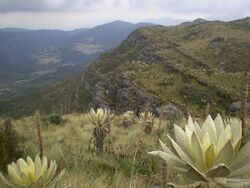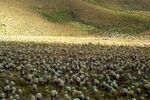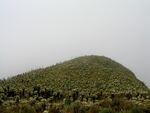Biology:Espeletia
| Espeletia | |
|---|---|

| |
| Espeletia in Páramo de Guerrero (Colombia) | |
| Scientific classification | |
| Kingdom: | Plantae |
| Clade: | Tracheophytes |
| Clade: | Angiosperms |
| Clade: | Eudicots |
| Clade: | Asterids |
| Order: | Asterales |
| Family: | Asteraceae |
| Subfamily: | Asteroideae |
| Tribe: | Millerieae |
| Subtribe: | Espeletiinae |
| Genus: | Espeletia Mutis ex Bonpl. in Humb. & Bonpl. |
| Synonyms[1] | |
| |
Espeletia, commonly known as 'frailejones' ("big monks"[2]), is a genus of perennial subshrubs, in the family Asteraceae.[3] The genus, which is native mainly to Colombia, Venezuela and Ecuador, was first formally described in 1808.[4] The genus was named after the viceroy of New Granada, José Manuel de Ezpeleta.
The plants live at high altitude in páramo ecosystems. The trunk is thick, with succulent hairy leaves disposed in a dense spiral pattern. Marcescent leaves help protect the plants from cold. The flowers are usually yellow, similar to daisies. Some members of the genus exhibit a caulirosulate growth habit.[5]
The frailejón plant is endangered due to destruction of the páramo for agricultural purposes, especially potato crops. This activity continues, despite the Colombian government declaring it illegal. Since about 2010 the plants have also come under attack by beetle larvae, a moth and a fungus, some new to science but suspected to be related to climate change which allows lower-altitude species to flourish.[2]
Espeletia is well known for contributing to the world in water sustainability by capturing water vapor from passing clouds in its spongy trunk and releasing it through the roots into the soil,[2] thus helping to create vast high-altitude subterranean water deposits and lakes that will eventually form rivers.
Species
Species accepted by Plants of the World Online as of December 2022:[1]
References
- ↑ 1.0 1.1 "Espeletia Bonpl.". Royal Botanic Gardens, Kew. 2022. https://powo.science.kew.org/taxon/urn:lsid:ipni.org:names:30003316-2.
- ↑ 2.0 2.1 2.2 Damian Carrington (9 April 2019). "In the land of El Dorado, clean water has become 'blue gold'". https://www.theguardian.com/environment/2019/apr/09/land-el-dorado-clean-water-blue-gold-paramos-colombia-andes.
- ↑ Tropicos, Espeletia Mutis ex Bonpl.
- ↑ Mutis, José Celestino Bruno ex Bonpland, Aimé Jacques Alexandre in Humboldt, Friedrich Wilhelm Heinrich Alexander von & Bonpland, Aimé Jacques Alexandre. 1808. Plantes équinoxiales recueillies au Mexique : dans l'île de Cuba, dans les provinces de Caracas, de Cumana et de Barcelone, aux Andes de la Nouvelle Grenade, de Quito et du Pérou, et sur les bords du rio-Negro de Orénoque et de la rivière des Amazones 2(9): 10-16 plates 70-72 descriptions in parallel French and Latin, commentary in French, full page line drawings
- ↑ Zinck, Joseph Alfred; Huber, Otto (2011). Peatlands of the Western Guayana Highlands, Venezuela. Springer Fachmedien. p. 56.
Further reading
- Padilla-González, G.F., Diazgranados, M., Da Costa, F.B.(2017) Biogeography shaped the metabolome of the genus Espeletia: a phytochemical perspective on an Andean adaptive radiation. Scientific Reports: ISSN 2045-2322 volume 7, Article number: 8835. pdf doi:10.1038/s41598-017-09431-7
External links
Wikidata ☰ Q290488 entry
 |






